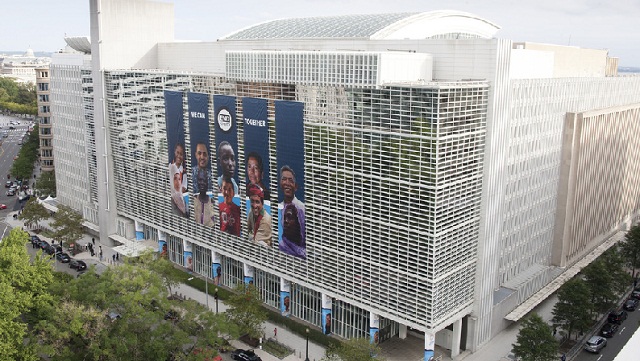
Washington, United States | AFP | The IMF and World Bank have aggressively pushed out financing to help countries deal with the health and economic impacts of the coronavirus pandemic.
Here is a summary of the financing available from the Washington-based development lenders:
– Regular lending capacity –
All members of the International Monetary Fund have access to the $1 trillion in lending capacity.
As of Thursday, 102 out of 189 IMF member countries had made requests for aid, and 50 of them will receive it by the end of April, IMF chief Kristalina Georgieva said following the virtual spring meetings.
The World Bank plans to provide up to $160 billion in aid over the next 15 months.
– Emergency aid –
The IMF’s emergency aid capacity recently was doubled to $100 billion, available through two tools: the Rapid Financing Instrument (RFI) and the Rapid Credit Facility (RCF).
The RCF is interest-free and accessible to low-income members, while the RFI is accessible to all members, without the need to negotiate a traditional loan program.
The funds “can be disbursed very quickly to assist member countries implement policies to address emergencies such as the coronavirus,” the IMF said.
– Disaster relief –
The IMF also uses its redesigned Catastrophe Containment and Relief Trust (CCRT) to provide grants for debt relief to the poorest and most vulnerable countries with outstanding obligations to the IMF to help address disasters, including public health disasters.
This instrument was used to support Guinea, Liberia and Sierra Leone during the 2014 Ebola epidemic.
The IMF board approved a six-month debt payment standstill for 25 countries eligible for CCRT funding, which potentially could be extended.
Georgieva put out an urgent call for donations to boost resources of this fund, and she said Thursday the IMF has received commitments totaling $600 million from Britain, Japan, China, the Netherlands and Germany.
– Poverty reduction fund –
Georgieva also has called for an additional $17 billion in donations to shore up the Poverty Reduction and Growth Trust (PRGT), which provides concessional lending to low-income countries.
She said the fund already has received commitments for 70 percent of this amount from Japan, Britain, France, Australia and Canada.
US Treasury Secretary Steven Mnuchin said the United States is considering a possible contribution.
– Short-term credit line –
For countries that are not eligible for concessional lending, the IMF on Wednesday approved a new Precautionary Liquidity Line (PLL) to help countries with “sound policies” deal with “adverse shocks” from the coronavirus.
The countries that qualify can draw on the credit backstop for six months, one year or two years.
– Funding field projects –
The World Bank intends to roll out $160 billion over the next 15 months in countries like Ethiopia, Afghanistan, Haiti, Ecuador, India, Mongolia and Tajikistan to strengthen their medical resources to respond to the pandemic’s immediate health crisis and bolster economic recovery.
The bank already has pushed out fast-track financing, with programs underway in 25 countries totaling $1.9 billion, and others moving forward in 40 countries amounting to $1.7 billion.
The focus is on “fast, broad-based action, especially for the poorest countries,” the World Bank President David Malpass said Thursday.
“By the end of April, we expect to have COVID-19-related projects in 100 countries, and we are taking steps to provide unprecedented financing to help countries respond to the crisis.”
 The Independent Uganda: You get the Truth we Pay the Price
The Independent Uganda: You get the Truth we Pay the Price




I want to draw your attention to the statement extracted from above.
“By the end of April, we expect to have COVID-19-related projects in 100 countries, and we are taking steps to provide unprecedented financing to help countries respond to the crisis.”
My question is “Is Uganda among the 100 countries that are expected to have COVID-19 related projects by end of April?”
If so, then my comment and proposal is as follow: As a Director of a Nursing and Midwifery School (Bweyale School of Nursing and Midwifery in Kiryandongo District, Uganda), I foresee a challenge of lack of PPEs, Masks, etc to protect the students from COVID-19 while doing clinical practice on the wards. I am cognizant of the fact that schools will only reopen after the COVID-19 is no longer a threat but the possibility of resurgence, re-emergence and or general protection from other contagious diseases may be so vital against the back drop that COVID-19 has ravaged the world and killed many health workers – now more than 52,000 health workers have died of COVID-19. Such an emerging disease, Ebola and haemorrhagic fevers inclusive, are causing setbacks in ambitions of young people in choosing to study and become health workers unless they are a bit sure of protection, notwithstanding the fact that all professions have occupational hazards but some may bear more risks than others and the health sector is becoming one.
My proposal therefore is for the IMF and World Bank to support private and public health training institutions either through rolling out their lending directly to the schools (more applicable to private health training institutions) or use one of the following strategies to finance health training institutions: Poverty reduction; Short-term credit line fund; Funding field projects; Emergency aid or Disaster Relief. The funds will be used amongst others to procure full sets of PPEs, Masks, Face Shields, etc and also for other related support. The funding mechanism can be discussed if the proposal is embraced.
Thanking you greatly for the positive response.
Dr Jackson Ojera Abusu
Email: abusujao100@gmail.com
+256777010442 / +256702720599